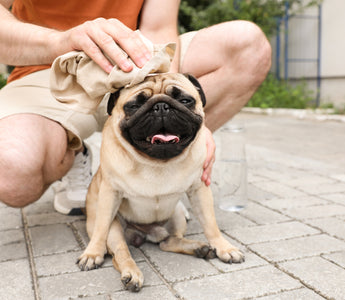As temperatures rise, it's essential to be mindful of how the heat can affect our furry friends. Dogs are particularly vulnerable to heat stroke, a potentially fatal condition that can develop rapidly. This blog will cover the symptoms of heat stroke in dogs, what to do if you suspect your dog is suffering from heat stroke, and how to prevent it. This information is vital and could save your dog's life. Let’s dive in!
What is Heat Stroke?
Heat stroke, commonly referred to as hyperthermia, occurs when a dog's body temperature exceeds 103°F (39.4°C). If it reaches 106°F (41°C) or higher, it's often due to excessive external heat and can lead to multiple organ failure and death if not treated immediately. Heat stroke can occur within 15 minutes under extreme conditions.
Dogs at Higher Risk
Certain dogs are more prone to heat stroke:- Brachycephalic breeds: Pugs, Boxers, Shih Tzus, Pekingese, Boston Terriers, French Bulldogs, and Bulldogs, due to their restricted airways.
- Puppies and Senior Dogs: Due to their weaker thermoregulatory systems.
- Dogs on certain medications: Such as diuretics, beta blockers, and sedatives.
- Overweight Dogs: They have more body mass to cool.
- Muzzled Dogs: Limited ability to pant increases their risk.
Symptoms of Heat Stroke in Dogs
Recognizing the early signs of heat stroke can make a significant difference in your dog's health. Key symptoms include:
- Excessive Panting and Difficulty Breathing: Rapid, heavy panting is often one of the first signs.
- Excessive Drooling: Thick, sticky saliva is a common symptom.
- Increased Heart Rate: Elevated heart rate can indicate heat stress.
- Red or Pale Gums and Tongue:Gums may appear bright red, pale, or even blue due to poor oxygen circulation. Gums will appear abnormal.
- Weakness or Lethargy: Your dog may become weak, tired, or unable to stand.
- Staggering or Difficulty Walking: Unsteady movements or collapsing can occur.
- Vomiting or Diarrhea:Often accompanied by blood.
- Confusion or Disorientation: Your dog may seem dazed or not respond to commands.
- Seizures: In severe cases, dogs may experience seizures.
- Unconsciousness: Loss of consciousness requires immediate emergency attention.
What to Do If Your Dog Has Heat Stroke
If you suspect your dog is suffering from heat stroke, act quickly but calmly:- Move to a Cooler Area: Get your dog out of the heat.
- Offer Water: Let your dog drink small amounts of cool (not ice-cold) water.
- Cool Your Dog Down: Use cool, wet towels on your dog's head, neck, stomach, armpits, feet, and groin area. Avoid using ice or very cold water.
- Keep the Cloths Cool: Replace them frequently to ensure they remain effective.
- Go to the Vet Immediately: Even if your dog seems to recover, they should be checked by a veterinarian. While on route to the vet's office be sure to keep your dog cool.
Prevention Tips
Preventing heat stroke is all about being proactive and mindful of your dog's environment and activities:- Avoid Hot Weather: Keep your dog indoors or in shaded areas during peak temperatures.
- Provide Plenty of Water: Ensure your dog always has access to fresh, cool water.
- Limit Exercise: Reduce intense exercise during hot weather. Opt for walking your dog in the morning and evening hours.
- Never Leave Your Dog in a Parked Car: THIS CAN'T BE STRESSED ENOUGH!! Temperatures can rise quickly, even with windows cracked.
- Use Cooling Aids: Provide cooling mats, cool water misters, and fans.
- Grooming: Keep your dog's coat well-groomed, but avoid shaving them completely, as too short of hair can cause sunburn.
Prognosis
The prognosis for dogs with heat stroke depends on their overall health, age, the severity of the heat stroke, and how quickly they receive treatment. While most dogs can recover quickly if treated immediately, some may suffer from permanent organ damage, be at increased risk for future heat stroke episodes, or even death.
Conclusion
Being aware of the signs of heat stroke and taking steps to prevent it can save your dog's life. During the hot summer months, always prioritize your dog's safety by keeping them cool, hydrated, and out of the sun during peak temperatures. If you suspect heat stroke, seek veterinary care immediately. Remember, the goal is to slowly decrease your dog's body temperature without causing shock. Stay hydrated, keep cool, and enjoy a safe summer with your furry friends! 😎
Thank you for reading our blog. We appreciate you and hope this information helps you keep your pets safe.
For more detailed information on heat stroke in dogs, you can visit trusted sources such as the American Kennel Club (AKC) and PetMD.
https://www.petmd.com/dog/general-health/how-hot-is-too-hot-for-dogs
https://vcahospitals.com/know-your-pet/heat-stroke-in-dogs














